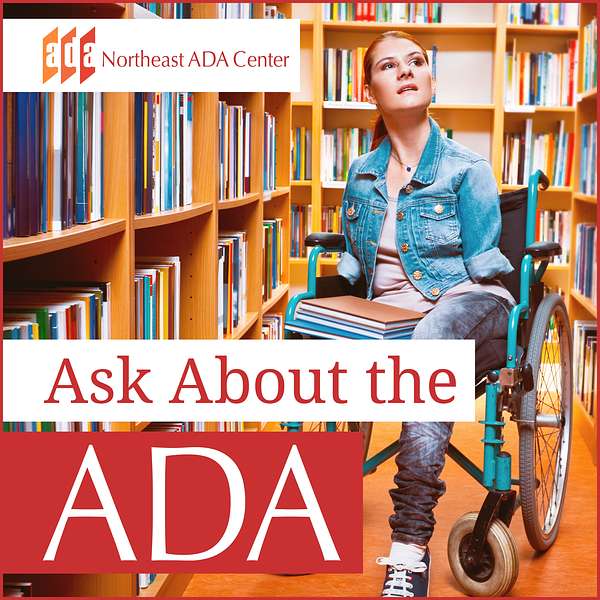
Ask About the ADA Podcast
The podcast answers frequently asked questions about the Americans with Disabilities Act and explores the rights and responsibilities of people with disabilities under the law.
Ask About the ADA Podcast
Ask About: Open and Closed Captioning Online
•
Northeast ADA Center
•
Season 1
•
Episode 11
Does the Americans with Disabilities Act apply to websites operated by the federal government? What is the difference between closed and open captioning? This edition of Ask About the ADA is all about web and online video accessibility. For a transcript of today's episode, please visit the Ask About the ADA podcast feed on BuzzSprout.
JOE ZESSKI: Hello and welcome to this edition of Ask About the ADA, the podcast where we answer frequently asked questions about the Americans with Disabilities Act. [MUSIC PLAYING] On today's episode, we're going to go talk about websites. Particular, we're going to talk about federal websites and about online video content. So that being said, let's dive right in. [MUSIC PLAYING] So here's our first question. Are federal websites covered by the Americans with Disabilities Act? Well, the answer here is no. Because of the way that the ADA itself was written, it generally does not apply to federal agencies or departments. And that includes their websites. Instead, there's a different law called the Rehabilitation Act that does apply in a lot of circumstances to federal agencies and departments. For example, Section 501 of the Rehabilitation Act applies to employment for federal agencies. Section 503 applies to federal contractors of a certain size. And many people also have heard of Section 504, which is a part of the law that applies to any organization that receives federal financial assistance. That being said Section 508, 508, of the Rehabilitation Act applies to federal websites. 508 requires federal agencies to make sure that their information and electronic technology is accessible. That's technology that they develop, that they procure and acquire, or that they use. This would include their web technology. So more specifically, federal agencies have to comply with the information and communication technology standards known as ICT that are created by the United States Access Board. Going into depth about Section 508 is another podcast in and of itself. But suffice to say that it incorporates previous standards, as well as international best practices, to create a unified accessibility standard for federal agencies to comply with on their websites. So getting back to the original question that we started with, no, federal websites are not covered by the ADA. But that being said, they still must be accessible to people with disabilities. And they must meet what's known as the Section 508 standard. [MUSIC PLAYING] So here's our next question. I'm trying to make videos on my website more accessible for my customers by adding captioning. Can you explain the difference between open and closed captions? This is a good question. And it's one that people often aren't quite sure what the right answer is or what it involves. And of course, adding captions to your videos make them accessible to people who may have a hearing-related disability but also to other people. It benefits those who just want to watch what's happening on a screen with the sound down. So it's not only an accessibility issue, but it also is a general convenience issue for people as well. So what is the difference between open and closed captioning? Well, first keep in mind what captioning is. And that is text that appears on the screen as a video plays. The text should communicate what's really essential to the audio. Now, this means more than just the spoken words. Of course, the words are essential. And having accurate transcription there is critical. But captioning also includes what you might refer to as nonspeech sounds. In other words, let's say you're watching a movie. And there are footsteps approaching from the distance. Or there's music that really is setting the mood or the atmosphere. Those details also should be communicated in captioning. So again, it's more than just a transcript of words. Captioning involves setting and communicating what is being communicated through sound, except in a written format. Now, open captioning means that the text that appears on screen is embedded in the video itself. And so it's always playing. It always appears. The user cannot turn off open captions. By contrast, closed captions are at the viewer's discretion. In other words, the user can turn those captions on or off. So when a business or any organization wants to publish accessible videos online, they have to put in planning and consideration into the process. This is because not all media players or streaming platforms support closed captioning. So when you are thinking about adding captions, there's a lot to consider, not only what type, open or closed captioning, but also, what's going to be the medium? What's going to support providing the captions? [MUSIC PLAYING] So that's it for today's episode of Ask About the ADA. Hope you enjoyed the information about federal websites and online video captioning. If you have any questions or would like to learn more, please feel free to contact us at the Northeast ADA. You can call our number 1-800-949-4232. You can email us at northeastada@cornell.edu, or visit the Northeast ADA website, which is northeastada.org. And of course, feel free to follow us on social media. Look for @northeastada on Facebook, Instagram, LinkedIn, Twitter, all the usual suspects for social media. I'd like to thank Grace Fairchild, our student worker at the Northeast ADA Center who produces and edits the show. I also would like to thank Peter Quinn of the Yang-Tan Institute media team for doing additional editing. I'm Joe Zesski, the program manager here at the Northeast ADA Center. Thanks for spending some time with me, and I look forward to continuing the conversation. [MUSIC PLAYING]